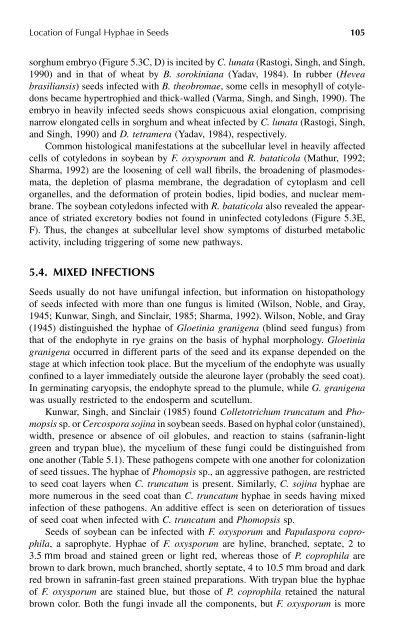Histopathology of Seed-Borne Infections - Applied Research Center ...
Histopathology of Seed-Borne Infections - Applied Research Center ...
Histopathology of Seed-Borne Infections - Applied Research Center ...
Create successful ePaper yourself
Turn your PDF publications into a flip-book with our unique Google optimized e-Paper software.
Location <strong>of</strong> Fungal Hyphae in <strong>Seed</strong>s 105sorghum embryo (Figure 5.3C, D) is incited by C. lunata (Rastogi, Singh, and Singh,1990) and in that <strong>of</strong> wheat by B. sorokiniana (Yadav, 1984). In rubber (Heveabrasiliansis) seeds infected with B. theobromae, some cells in mesophyll <strong>of</strong> cotyledonsbecame hypertrophied and thick-walled (Varma, Singh, and Singh, 1990). Theembryo in heavily infected seeds shows conspicuous axial elongation, comprisingnarrow elongated cells in sorghum and wheat infected by C. lunata (Rastogi, Singh,and Singh, 1990) and D. tetramera (Yadav, 1984), respectively.Common histological manifestations at the subcellular level in heavily affectedcells <strong>of</strong> cotyledons in soybean by F. oxysporum and R. bataticola (Mathur, 1992;Sharma, 1992) are the loosening <strong>of</strong> cell wall fibrils, the broadening <strong>of</strong> plasmodesmata,the depletion <strong>of</strong> plasma membrane, the degradation <strong>of</strong> cytoplasm and cellorganelles, and the deformation <strong>of</strong> protein bodies, lipid bodies, and nuclear membrane.The soybean cotyledons infected with R. bataticola also revealed the appearance<strong>of</strong> striated excretory bodies not found in uninfected cotyledons (Figure 5.3E,F). Thus, the changes at subcellular level show symptoms <strong>of</strong> disturbed metabolicactivity, including triggering <strong>of</strong> some new pathways.5.4. MIXED INFECTIONS<strong>Seed</strong>s usually do not have unifungal infection, but information on histopathology<strong>of</strong> seeds infected with more than one fungus is limited (Wilson, Noble, and Gray,1945; Kunwar, Singh, and Sinclair, 1985; Sharma, 1992). Wilson, Noble, and Gray(1945) distinguished the hyphae <strong>of</strong> Gloetinia granigena (blind seed fungus) fromthat <strong>of</strong> the endophyte in rye grains on the basis <strong>of</strong> hyphal morphology. Gloetiniagranigena occurred in different parts <strong>of</strong> the seed and its expanse depended on thestage at which infection took place. But the mycelium <strong>of</strong> the endophyte was usuallyconfined to a layer immediately outside the aleurone layer (probably the seed coat).In germinating caryopsis, the endophyte spread to the plumule, while G. granigenawas usually restricted to the endosperm and scutellum.Kunwar, Singh, and Sinclair (1985) found Colletotrichum truncatum and Phomopsissp. or Cercospora sojina in soybean seeds. Based on hyphal color (unstained),width, presence or absence <strong>of</strong> oil globules, and reaction to stains (safranin-lightgreen and trypan blue), the mycelium <strong>of</strong> these fungi could be distinguished fromone another (Table 5.1). These pathogens compete with one another for colonization<strong>of</strong> seed tissues. The hyphae <strong>of</strong> Phomopsis sp., an aggressive pathogen, are restrictedto seed coat layers when C. truncatum is present. Similarly, C. sojina hyphae aremore numerous in the seed coat than C. truncatum hyphae in seeds having mixedinfection <strong>of</strong> these pathogens. An additive effect is seen on deterioration <strong>of</strong> tissues<strong>of</strong> seed coat when infected with C. truncatum and Phomopsis sp.<strong>Seed</strong>s <strong>of</strong> soybean can be infected with F. oxysporum and Papulaspora coprophila,a saprophyte. Hyphae <strong>of</strong> F. oxysporum are hyline, branched, septate, 2 to3.5 mm broad and stained green or light red, whereas those <strong>of</strong> P. coprophila arebrown to dark brown, much branched, shortly septate, 4 to 10.5 mm broad and darkred brown in safranin-fast green stained preparations. With trypan blue the hyphae<strong>of</strong> F. oxysporum are stained blue, but those <strong>of</strong> P. coprophila retained the naturalbrown color. Both the fungi invade all the components, but F. oxysporum is more


